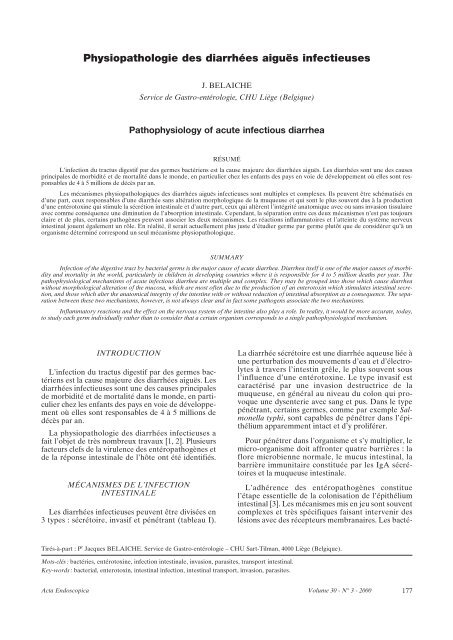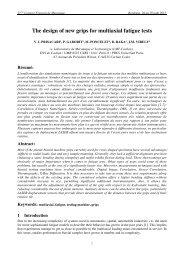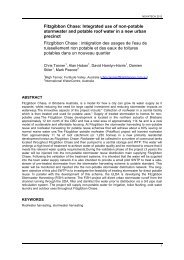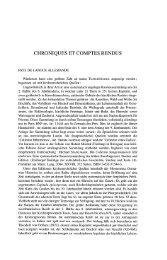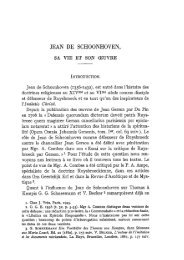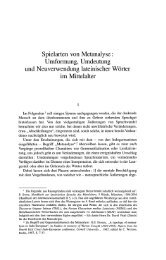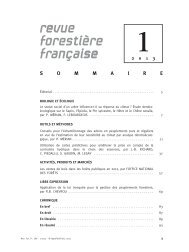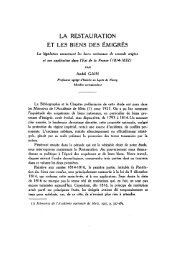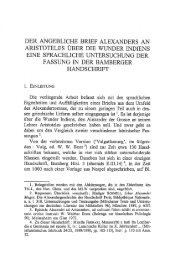Physiopathologie des diarrhées aiguës infectieuses
Physiopathologie des diarrhées aiguës infectieuses
Physiopathologie des diarrhées aiguës infectieuses
Create successful ePaper yourself
Turn your PDF publications into a flip-book with our unique Google optimized e-Paper software.
<strong>Physiopathologie</strong> <strong>des</strong> <strong>diarrhées</strong> <strong>aiguës</strong> <strong>infectieuses</strong><br />
INTRODUCTION<br />
L’infection du tractus digestif par <strong>des</strong> germes bactériens<br />
est la cause majeure <strong>des</strong> <strong>diarrhées</strong> <strong>aiguës</strong>. Les<br />
<strong>diarrhées</strong> <strong>infectieuses</strong> sont une <strong>des</strong> causes principales<br />
de morbidité et de mortalité dans le monde, en particulier<br />
chez les enfants <strong>des</strong> pays en voie de développement<br />
où elles sont responsables de 4 à 5 millions de<br />
décès par an.<br />
La physiopathologie <strong>des</strong> <strong>diarrhées</strong> <strong>infectieuses</strong> a<br />
fait l’objet de très nombreux travaux [1, 2]. Plusieurs<br />
facteurs clefs de la virulence <strong>des</strong> entéropathogènes et<br />
de la réponse intestinale de l’hôte ont été identifiés.<br />
MÉCANISMES DE L’INFECTION<br />
INTESTINALE<br />
Les <strong>diarrhées</strong> <strong>infectieuses</strong> peuvent être divisées en<br />
3 types : sécrétoire, invasif et pénétrant (tableau I).<br />
J. BELAICHE<br />
Service de Gastro-entérologie, CHU Liège (Belgique)<br />
Pathophysiology of acute infectious diarrhea<br />
RÉSUMÉ<br />
L’infection du tractus digestif par <strong>des</strong> germes bactériens est la cause majeure <strong>des</strong> <strong>diarrhées</strong> <strong>aiguës</strong>. Les <strong>diarrhées</strong> sont une <strong>des</strong> causes<br />
principales de morbidité et de mortalité dans le monde, en particulier chez les enfants <strong>des</strong> pays en voie de développement où elles sont responsables<br />
de 4 à 5 millions de décès par an.<br />
Les mécanismes physiopathologiques <strong>des</strong> <strong>diarrhées</strong> <strong>aiguës</strong> <strong>infectieuses</strong> sont multiples et complexes. Ils peuvent être schématisés en<br />
d’une part, ceux responsables d’une diarrhée sans altération morphologique de la muqueuse et qui sont le plus souvent dus à la production<br />
d’une entérotoxine qui stimule la sécrétion intestinale et d’autre part, ceux qui altèrent l’intégrité anatomique avec ou sans invasion tissulaire<br />
avec comme conséquence une diminution de l’absorption intestinale. Cependant, la séparation entre ces deux mécanismes n’est pas toujours<br />
claire et de plus, certains pathogènes peuvent associer les deux mécanismes. Les réactions inflammatoires et l’atteinte du système nerveux<br />
intestinal jouent également un rôle. En réalité, il serait actuellement plus juste d’étudier germe par germe plutôt que de considérer qu’à un<br />
organisme déterminé correspond un seul mécanisme physiopathologique.<br />
SUMMARY<br />
Infection of the digestive tract by bacterial germs is the major cause of acute diarrhea. Diarrhea itself is one of the major causes of morbidity<br />
and mortality in the world, particularly in children in developing countries where it is responsible for 4 to 5 million deaths per year. The<br />
pathophysiological mechanisms of acute infectious diarrhea are multiple and complex. They may be grouped into those which cause diarrhea<br />
without morphological alteration of the mucosa, which are most often due to the production of an enterotoxin which stimulates intestinal secretion,<br />
and those which alter the anatomical integrity of the intestine with or without reduction of intestinal absorption as a consequence. The separation<br />
between these two mechanisms, however, is not always clear and in fact some pathogens associate the two mechanisms.<br />
Inflammatory reactions and the effect on the nervous system of the intestine also play a role. In reality, it would be more accurate, today,<br />
to study each germ individually rather than to consider that a certain organism corresponds to a single pathophysiological mechanism.<br />
La diarrhée sécrétoire est une diarrhée aqueuse liée à<br />
une perturbation <strong>des</strong> mouvements d’eau et d’électrolytes<br />
à travers l’intestin grêle, le plus souvent sous<br />
l’influence d’une entérotoxine. Le type invasif est<br />
caractérisé par une invasion <strong>des</strong>tructrice de la<br />
muqueuse, en général au niveau du colon qui provoque<br />
une dysenterie avec sang et pus. Dans le type<br />
pénétrant, certains germes, comme par exemple Salmonella<br />
typhi, sont capables de pénétrer dans l’épithélium<br />
apparemment intact et d’y proliférer.<br />
Pour pénétrer dans l’organisme et s’y multiplier, le<br />
micro-organisme doit affronter quatre barrières : la<br />
flore microbienne normale, le mucus intestinal, la<br />
barrière immunitaire constituée par les IgA sécrétoires<br />
et la muqueuse intestinale.<br />
L’adhérence <strong>des</strong> entéropathogènes constitue<br />
l’étape essentielle de la colonisation de l’épithélium<br />
intestinal [3]. Les mécanismes mis en jeu sont souvent<br />
complexes et très spécifiques faisant intervenir <strong>des</strong><br />
lésions avec <strong>des</strong> récepteurs membranaires. Les bacté-<br />
Tirés-à-part : P r Jacques BELAICHE. Service de Gastro-entérologie – CHU Sart-Tilman, 4000 Liège (Belgique).<br />
Mots-clés: bactéries, entérotoxine, infection intestinale, invasion, parasites, transport intestinal.<br />
Key-words: bacterial, enterotoxin, intestinal infection, intestinal transport, invasion, parasites.<br />
Acta Endoscopica Volume 30 - N° 3 - 2000<br />
177
ies utilisent <strong>des</strong> adhésines qui sont <strong>des</strong> lectines ou<br />
<strong>des</strong> «lectine-like »qui agissent avec <strong>des</strong> sucres spécifiques<br />
situés sur les microvillosités membranaires.<br />
Les adhésines adhèrent à la bordure en brosse en se<br />
fixant en général au sommet <strong>des</strong> microvillosités. Une<br />
dizaine de facteurs d’adhésion sont actuellement<br />
décrits. Ils sont appelés CFA (Colonisation Factor<br />
Antigène). Ils sont généralement pathogènes et hôtes<br />
spécifiques. Les plus étudiés ont été ceux de l’entérotoxinogène<br />
(ETEC) à E. coli. La fixation de la bactérie<br />
est liée à la présence à l’extérieur de la capsule<br />
microbienne, d’appendices filamenteux appelés fimbriae,<br />
antigéniques, reconnaissant un site spécifique<br />
sur l’entérocyte. Ces fimbriae sont spécifiques <strong>des</strong><br />
espèces animales auxquelles l’E. coli s’attaque. Elles<br />
sont de plus, liées aux plasmi<strong>des</strong> et peuvent, de ce<br />
fait, être transférées à <strong>des</strong> groupes bactériens qui initialement<br />
n’étaient pas aptes à les produire. Certaines<br />
adhésines peuvent se fixer de façon plus diffuse à la<br />
surface membranaire. C’est le cas d’Entamoeba histolitica<br />
qui possède une galactose-binding lectine spécifique<br />
jouant un rôle clef dans l’adhésion du parasite à<br />
l’épithélium colique. C’est également le cas de la lamblia<br />
qui possède une mannose-binding lectine qui<br />
contribue à son adhérence à l’épithélium intestinal.<br />
Certains entéropathogènes (entéropathogène (EPC)<br />
à E. coli, Cryptosporidiumparvum ) adhèrent étroitement<br />
à la membrane apicale de l’entérocyte et détruisent<br />
les microvillosités.<br />
A côté <strong>des</strong> adhésines, d’autres facteurs interviennent<br />
dans l’agressivité <strong>des</strong> micro-organismes : mobilité,<br />
production d’enzymes mucolytiques, chimiotactisme,<br />
production d’entérotoxine, de cytotoxines et<br />
de facteurs permettant la pénétration de la<br />
muqueuse.<br />
178<br />
PHYSIOPATHOLOGIE DES DIARRHÉES<br />
INFECTIEUSES<br />
A l’étape fonctionnelle, les <strong>diarrhées</strong> <strong>infectieuses</strong><br />
peuvent être considérées comme étant la conséquence<br />
soit d’une augmentation de la sécrétion intestinale,<br />
qui survient le plus souvent en l’absence de<br />
T ABLEAU I<br />
PRINCIPAUX TYPES D’INFECTIONS INTESTINALES<br />
Sécrétoire Invasif Pénétrant<br />
Mécanisme entérotoxine cytotoxique survie intracellulaire<br />
Site grêle colon grêle<br />
Type de diarrhée hydrique dysenterie dépend du germe<br />
Germes V. cholera Shigella S. typhi<br />
E. coli toxi labile Campylobacter jejuni Yersinia enterolitica<br />
E. coli toxi stable S. enteritidis Rotavirus<br />
E. coli invasif Virus Norwalk<br />
C. difficile<br />
C. perfringens<br />
Staphylocoques<br />
lésions macro- ou microscopiques de l’intestin et qui<br />
est liée à la production d’une toxine, soit d’une diminution<br />
de l’absorption intestinale secondaire à <strong>des</strong><br />
lésions tissulaires et/ou inflammatoires [2]. Cependant,<br />
la séparation entre ces deux mécanismes n’est<br />
pas toujours claire et de plus certains pathogènes<br />
peuvent associer les 2 mécanismes.<br />
Augmentation de la sécrétion intestinale<br />
L’augmentation de la sécrétion intestinale au cours<br />
<strong>des</strong> <strong>diarrhées</strong> <strong>infectieuses</strong> peut être liée à la présence<br />
d’entérotoxine, de sécrétagogues endogènes comme<br />
le 5-HT et <strong>des</strong> médiateurs inflammatoires, le tout<br />
pouvant être amplifié par le système nerveux entérique.<br />
Entérotoxines<br />
Les entérotoxines bactériennes comme celles de la<br />
toxine cholérique et celles thermolabiles (TL) et thermostables<br />
(TS) d’ E. coli sont <strong>des</strong> causes fréquentes<br />
de diarrhée en particulier dans les pays en voie de<br />
développement. Les bactéries qui produisent ces<br />
toxines sont responsables d’une diarrhée sécrétoire<br />
qui a trois caractéristiques majeures. La première est<br />
une sécrétion nette d’eau et d’électrolytes due à la<br />
sécrétion active de Cl¯ et à une inhibition de l’absorption<br />
de NaCl. La seconde, est l’absence d’anomalie<br />
morphologique. Enfin, ces pathogènes n’altèrent pas<br />
l’absorption du sodium glucodépendant, d’où la possibilité<br />
d’utiliser <strong>des</strong> solutions orales sucrées enrichies<br />
en électrolytes pour traiter la déshydratation.<br />
D’une façon générale, ces entérotoxines sont sous<br />
contrôle génétique et principalement par la voie <strong>des</strong><br />
plasmi<strong>des</strong>. Une fois produite dans la lumière intestinale,<br />
la toxine déclenche une diarrhée, en passant par<br />
les étapes suivantes : fixation de la toxine sur son<br />
récepteur membranaire spécifique, transmission du<br />
signal à travers la paroi membranaire et stimulation<br />
d’un second messager intracellulaire, enfin perturbation<br />
<strong>des</strong> échanges de l’eau et <strong>des</strong> électrolytes.<br />
La toxine cholérique représente l’archétype de la<br />
diarrhée toxinogène [4]. Le Vibrio choléra 01 produit<br />
une entérotoxine qui est un peptide complexe (PM<br />
Volume 30 - N° 3 - 2000 Acta Endoscopica
84 000). Elle se compose de 5 sous-unités B nécessaires<br />
à l’attachement de la toxine à la cellule qui forment<br />
une couronne autour de la sous-unité A, partie<br />
active de la molécule. Cette sous-unité A est ellemême<br />
constituée de deux parties A1 et A2. L’action<br />
sécrétoire de la toxine cholérique fait intervenir plusieurs<br />
étapes. La première est la fixation du vibrion<br />
sur la muqueuse intestinale. La deuxième, lorsque la<br />
bactérie est fixée, est la production de toxine. La couronne<br />
périphérique <strong>des</strong> sous-unités B se fixe à la surface<br />
de l’entérocyte à un récepteur ganglioside appelé<br />
GM1, puis libère la sous-unité A qui pénètre la membrane<br />
entérocytaire. A l’intérieur de cette membrane,<br />
la sous-unité A s’ouvre en A1 et A2. La partie<br />
A1 réagit dans la membrane avec NAD catalysant la<br />
production de NAD-Ribose. C’est le NAD ribose qui<br />
libère l’adénylate cyclase situé au pole basal de l’entérocyte.<br />
A l’étape suivante, l’adénylate cyclase provoque<br />
la conversion de l’ATP en AMP cyclique. La<br />
réaction catalysée par le peptide A1 modifie de façon<br />
covalente l’affinité de l’adénylate cyclase ce qui a<br />
pour conséquence de modifier son affinité pour ses<br />
substrats. Il en résulte une formation irréversible<br />
d’AMP cyclique à une concentration énorme, à partir<br />
de l’ATP intracellulaire. L’AMP cyclique qui agit<br />
comme un second messager active alors une cascade<br />
biochimique aboutissant à la phosphorylation de plusieurs<br />
protéines intervenant dans les mouvements<br />
d’eau et d’électrolytes. L’effet final est une inhibition<br />
de l’absorption de NaCl et une stimulation de la<br />
sécrétion de Cl ¯ aboutissant à une accumulation de<br />
liquide dans la lumière intestinale et expliquant la<br />
diarrhée.<br />
Les toxines produites par E. coli se divisent en<br />
entérotoxine labile à la chaleur (LT) et entérotoxine<br />
thermostable (ST) [4]. La LT est une protéine de<br />
84.000 daltons dont le mécanisme d’action est semblable<br />
à la toxine cholérique. La ST est de poids<br />
moléculaire plus faible (2000 daltons) et stimule le<br />
cycle de la GMP (guanyl cyclase cyclique) mais sans<br />
entraîner de modification covalente de l’enzyme. La<br />
stimulation de la GMP active <strong>des</strong> kinases qui interviennent<br />
dans le transport de l’eau et <strong>des</strong> électrolytes.<br />
Cependant, contrairement à la toxine cholérique,<br />
l’entérotoxine ST semble inhibée préférentiellement<br />
l’absorption du Nacl et stimuler de façon limitée la<br />
sécrétion de Cl. Ceci explique que la diarrhée a tendance<br />
à être moins sévère.<br />
D’autres bactéries sont capables de produire <strong>des</strong><br />
entérotoxines ST en particulier Yersinia enterolitica<br />
et Vibrion cholérique autre que 01 [4]. Des étu<strong>des</strong><br />
récentes suggèrent que le Vibrion choléra 01 peut<br />
produire une deuxième entérotoxine qui contribuerait<br />
à la diarrhée sécrétoire (toxine zonula occludens).<br />
Sécrétagogues endogènes<br />
Il est actuellement admis que la toxine cholérique<br />
peut entraîner une libération de toute une série de<br />
sécrétagogues endogènes qui participent aux mécanismes<br />
de la diarrhée : 5 hydroxytryptamine (5-HT),<br />
VIP, neurotensine et prostaglandines.<br />
La 5-HT a été la plus étudiée [5]. La toxine cholérique<br />
serait capable de dégranuler les cellules entérochromaffines<br />
like provoquant une libération de 5-HT<br />
qui favoriserait la sécrétion de Cl¯ par un effet paracrine<br />
mais aussi en agissant sur les plexus sous<br />
muqueux et les plexus myentériques par l’intermédiaire<br />
du VIP et de l’acéthylcholine.<br />
Médiateurs inflammatoires<br />
Les entéropathogènes peuvent induire <strong>des</strong> phénomènes<br />
inflammatoires de la muqueuse intestinale qui<br />
peuvent être aigus et transitoires comme dans les dysenteries<br />
bactériennes ou chroniques et dans certaines<br />
parasitoses telles la lamblia. Il en résulte une libération<br />
de médiateurs aussi bien au niveau du grêle que<br />
du colon comme de l’histamine, <strong>des</strong> prostaglandines,<br />
<strong>des</strong> leukotriènes, <strong>des</strong> kinines et <strong>des</strong> cytokines. A côté<br />
de l’augmentation de la perméabilité intestinale liée à<br />
la <strong>des</strong>truction tissulaire, l’inflammation peut aussi stimuler<br />
ou inhiber l’absorption de l’eau et <strong>des</strong> électrolytes,<br />
stimuler le péristaltisme intestinal et enfin être<br />
responsable d’une maldigestion et d’une malabsorption<br />
<strong>des</strong> nutriments [2].<br />
Diminution de l’absorption intestinale<br />
C’est le mécanisme principal <strong>des</strong> <strong>diarrhées</strong> dues à<br />
<strong>des</strong> infections entéropathogènes. Contrairement aux<br />
<strong>diarrhées</strong> sécrétoires, elles s’accompagnent de lésions<br />
tissulaires macroscopiques ou microcopiques qui<br />
peuvent siéger soit au niveau du grêle soit au niveau<br />
du colon et qui modifient les processus de transport<br />
épithélial. Les mécanismes expliquant la diarrhée<br />
sont multiples : troubles de l’absorption de l’eau et<br />
<strong>des</strong> électrolytes au niveau du grêle, apparition au<br />
niveau du colon de nutriments incomplètement<br />
absorbés au niveau du grêle et qui induisent une diarrhée<br />
osmotique, lésions coliques entravant l’absorption<br />
colique. De plus l’accélération du transit intestinal<br />
peut aussi participer à la malabsorption par<br />
diminution du temps de contact avec les surfaces<br />
absorbantes.<br />
Les principales lésions tissulaires <strong>des</strong> <strong>diarrhées</strong><br />
avec malabsorption intestinale sont données sur le<br />
tableau II. L’ E. coli entéropathogène (EPEC), cause<br />
importante de diarrhée aiguë grave de l’enfant est<br />
responsable de lésions caractéristiques au niveau de<br />
l’entérocyte avec <strong>des</strong>truction <strong>des</strong> microvillosités sans<br />
invasion cellulaire [6]. Les bactéries adhèrent étroitement<br />
à la membrane entérocytaire qui forme une<br />
sorte de pié<strong>des</strong>tal en forme de coupe sur lequel elles<br />
sont fixées. L’interaction bactéries-cellule comporte<br />
donc un double effet : la <strong>des</strong>truction (le terme «d’effacement»est<br />
employé) <strong>des</strong> microvillosités et l’attachement<br />
à la membrane apicale de l’entérocyte; elle<br />
est désignée sous le terme «effet d’effacement et<br />
d’attachement». La disparition <strong>des</strong> microvillosités est<br />
un élément important dans la genèse de la diarrhée.<br />
Des atrophies villositaires d’intensité variable peuvent<br />
s’observer avec plusieurs entéropathogènes en<br />
particulier au cours <strong>des</strong> infections à rotavirus et certaines<br />
parasitoses.<br />
Acta Endoscopica Volume 30 - N° 3 - 2000 179
180<br />
T ABLEAU II<br />
PRINCIPALES LÉSIONS TISSULAIRES AU COURS<br />
DES DIARRHÉES INFECTIEUSES<br />
AVEC MALABSORPTION<br />
Atteinte bordure en brosse<br />
E. coli entéropathogène<br />
E. coli entérohémorragique<br />
Cryptosporidium parvum<br />
Giardia lamblia<br />
Atteinte épihéliale<br />
Shigella<br />
Salmonella<br />
Yersinia enterolitica<br />
E. coli entéroinvasif<br />
Campylobacter jejuni<br />
Clostridium difficile<br />
Atrophie villositaire<br />
Giardia<br />
Cryptosporidium parvum<br />
Isospora belli<br />
Rotavirus<br />
Les shigelles , l’E. coli entéro-invasif (EIEC) sont<br />
<strong>des</strong> germes entéro-invasifs car ils ont la capacité d’envahir<br />
l’épithélium de la muqueuse intestinale [7]. Les<br />
phénomènes pathologiques caractérisant la shigellose<br />
sont liés à deux particularités : le pouvoir invasif<br />
du germe et sa capacité à sécréter une cytotoxine, la<br />
vérotoxine (VT). Il en résulte une importante <strong>des</strong>truction<br />
tissulaire prédominant au niveau du colon<br />
sigmoïde et du rectum responsable d’un syndrome<br />
dysentérique sévère. L’activation de la VT passe par<br />
une fixation sur la cellule intestinale au niveau d’un<br />
ou peut-être deux récepteurs spécifiques, suivie d’une<br />
internalisation par endocytose. Son action au niveau<br />
de la synthèse protéique conduit à la mort cellulaire.<br />
L’infection à Clostridium difficile qui est responsable<br />
<strong>des</strong> <strong>diarrhées</strong> induites par les antibiotiques et<br />
<strong>des</strong> colites pseudomembraneuses représente un autre<br />
exemple de germe produisant <strong>des</strong> cytotoxines [4, 8].<br />
Cette bactérie non-invasive produit 2 toxines<br />
majeures qui sont thermolabiles et de poids moléculaires<br />
élevés, la toxine A et la toxine B qui ont pu être<br />
clonées et séquencées. Ces toxines induisent de la<br />
diarrhée par <strong>des</strong> mécanismes différents. La toxine A<br />
induit d’une part d’importantes modifications de la<br />
structure du cytosquelette et d’autre part, stimule la<br />
sécrétion de liquide. De plus, bien que considérée<br />
comme une entérotoxine, elle peut aussi induire une<br />
inflammation muqueuse et entraîner l’apparition de<br />
lésions muqueuses hémorragiques chez l’animal. En<br />
revanche, la toxine B ne semble pas avoir d’effet<br />
direct sur l’épithélium ou le transport intestinal. Elle<br />
est par contre utile au diagnostic de l’infection. La<br />
toxine B est connue pour être un activateur puissant<br />
de l’inflammation et avoir un effet cytopathogène. La<br />
cytotoxicité est 1000 fois supérieure à celle de la<br />
toxine A. Il existe cependant <strong>des</strong> arguments pour un<br />
rôle synergique <strong>des</strong> deux toxines dans le développe-<br />
ment <strong>des</strong> colites postantibiotiques. La toxine A stimule<br />
la sécrétion nette d’eau et d’électrolytes et donc<br />
l’apparition de la diarrhée par 3 mécanismes. Elle est<br />
responsable d’une augmentation de la perméabilité<br />
intestinale par un mécanisme qui n’est pas totalement<br />
élucidé. L’augmentation de la perméabilité intestinale<br />
peut partiellement augmenter la transsudation<br />
de liquide plasmatique dans la lumière de l’intestin et<br />
peut faciliter la rétrodiffusion de l’eau et <strong>des</strong> électrolytes<br />
déjà absorbés. L’augmentation de la perméabilité<br />
muqueuse faciliterait aussi la pénétration de la<br />
toxine B cytotoxique. La toxine A peut aussi stimuler<br />
la sécrétion de Cl¯, probablement par une action<br />
directe sur la muqueuse intestinale. L’hypersécrétion<br />
peut aussi être la conséquence d’une libération de<br />
médiateurs immunitaires et inflammatoires. Ces<br />
médiateurs à leur tour stimulent la sécrétion de Cl¯<br />
soit directement par l’intermédiaire de récepteurs<br />
membranaires spécifiques soit indirectement par l’activation<br />
d’autres cellules comme les neurones entériques,<br />
les neutrophiles et les fibroblastes sous épithéliaux.<br />
TROUBLES DE LA MOTRICITÉ<br />
INTESTINALE<br />
Il est probable que <strong>des</strong> troubles de la motilité intestinale<br />
interviennent au cours <strong>des</strong> <strong>diarrhées</strong> <strong>infectieuses</strong><br />
[2, 5]. Le bénéfice thérapeutique <strong>des</strong> ralentisseurs<br />
du transit en particulier <strong>des</strong> opiacés étaye cette<br />
hypothèse. Il existe <strong>des</strong> argument montrant que les<br />
entérotoxines agissent sur les composants myoélectriques<br />
et augmentent l’activité propulsive distale.<br />
Les médiateurs de la sécrétion intestinale et de l’inflammation<br />
comme les prostaglandines, les leukotriènes<br />
pourraient aussi agir sur la motilité en stimulant<br />
la musculature lisse.<br />
CONCLUSION<br />
Les mécanismes par lesquels les entéropathogènes<br />
produisent de la diarrhée sont multiples et complexes.<br />
Ils peuvent être schématisés en d’une part ceux responsables<br />
d’une diarrhée sans altération morphologiques<br />
de la muqueuse et qui sont le plus souvent dus<br />
à la production d’une entérotoxine qui stimule la<br />
sécrétion intestinale et d’autre part, ceux qui altèrent<br />
l’intégrité anatomique avec ou sans invasion tissulaire.<br />
Cependant, la séparation entre ces deux mécanismes<br />
n’est pas toujours claire et de plus, certains<br />
pathogènes peuvent associer les deux mécanismes.<br />
Les réactions inflammatoires et l’atteinte du système<br />
nerveux intestinal jouent également un rôle. En réalité,<br />
il serait actuellement plus juste d’étudier germe<br />
par germe plutôt que de considérer qu’à un organisme<br />
déterminé correspond un seul mécanisme physiopathologique<br />
[1].<br />
Volume 30 - N° 3 - 2000 Acta Endoscopica
1. BOOTH I.W., McNEISH A.S. — Mechanism of diarrhoea.<br />
Baillière’s Clinical Gastroenterology, 1993, 7, 215-241.<br />
2. FARTHING M.J.G. — Pathophysiology of infective diarrhoea.<br />
Eur. J. Gastroenterol. Hepatol., 1993, 5, 796-807.<br />
3. CONTREPOIS M. — Adhérence bactérienne et colonisation<br />
<strong>des</strong> muqueuses digestives. In : Rambaud JC, Rampal P. eds.<br />
Diarrhées <strong>aiguës</strong> <strong>infectieuses</strong>. Doin (Paris), 1993, 11-19.<br />
4. CZERUCKA D., RAMPAL P. — Toxines bactériennes et<br />
<strong>diarrhées</strong> <strong>aiguës</strong>. In : Rambaud JC, Rampal P. eds. Diarrhées<br />
<strong>aiguës</strong> <strong>infectieuses</strong>. Doin (Paris), 1993, 29-41.<br />
5. FARTHING M.J.G., TURVILL J.L. — Intestinal absorption<br />
and secretion : role of the enteric nervous system. In : Galmiche<br />
J.P., Gournay J. eds. Recent advance in the pathophy-<br />
INTRODUCTION<br />
Infection of the digestive tract is the major cause of<br />
acute diarrhea. Infectious diarrhea is one of the major<br />
causes of morbidity and mortality in the world, particularly<br />
in children in developing countries where they<br />
are responsible for four to five million deaths per year.<br />
The pathophysiology of infectious diarrhea has<br />
been the subject of numerous studies [1, 2] . Several key<br />
factors of the virulence of enteropathogens and the<br />
intestinal response of the host have been identified.<br />
MECHANISMS OF INTESTINAL INFECTION<br />
Infectious diarrhea may be divided into three types:<br />
secretory, invasive and penetrating (table I). Secretory<br />
diarrhea is liquid diarrhea linked to a perturbation of<br />
the movement of water and electrolytes across the<br />
small intestine, most often related to an enterotoxin.<br />
Invasive diarrhea is characterized by the <strong>des</strong>tructive<br />
invasion of the mucosa, generally at the level of the<br />
colon, which provokes dysentery with blood and puss.<br />
In the penetrating type, certain germs, for example Sal-<br />
RÉFÉRENCES<br />
T ABLE I<br />
MAIN TYPES OF INTESTINAL INFECTIONS<br />
siology of gastro-intestinal and liver diseases. John Libbey<br />
Eurotext (Paris), 1997, 173-183.<br />
6. JOLY B., DARFEUILLE-MICHAUD A., AUBEL D.,<br />
JALLAT C. — Les <strong>diarrhées</strong> à ETC et à EPEC. In : Rambaud<br />
J.C., Rampal P. eds. Diarrhées <strong>aiguës</strong> <strong>infectieuses</strong>. Doin<br />
(Paris), 1993, 53-65.<br />
7. MEICLER C., CERF M. — Diarrhées à shigelles, à colibacilles<br />
entéro-invasifs entéro-hémorragiques et à colibacilles.<br />
In : Rambaud J.C., Rampal P. eds. Diarrhées <strong>aiguës</strong> <strong>infectieuses</strong>.<br />
Doin (Paris), 1993, 67-76.<br />
8. MARTEAU P., LAVERGNE A. — Clostridium difficile. In :<br />
Rambaud J.C., Rampal P. eds. Diarrhées <strong>aiguës</strong> <strong>infectieuses</strong>.<br />
Doin (Paris), 1993, 113-122.<br />
monella typhi, are able to penetrate the apparently<br />
intact epithelium and proliferate.<br />
In order to penetrate into the body and multiply, a<br />
micro-organism must cross four barriers : the normal<br />
microbial flora, the intestinal mucus, the immune barrier<br />
composed of secretory IgA and the intestinal<br />
mucosa. Adherence of enteropathogens to the intestinal<br />
epithelium is the essential step required for colonisation<br />
[3] . The mechanisms through which this occurs<br />
are often complex and very specific, combining both<br />
lesions and membrane receptors. Bacteria use adhesins,<br />
which are lectins or «lectin-like » molecules,<br />
which react with specific sugars expressed on microvilli<br />
membranes. The adhesins generally attach to the<br />
extremity of microvilli. A dozen adhesion factors have<br />
been <strong>des</strong>cribed. They are called CFA (Colonisation<br />
Factor Antigens). They are generally pathogen and<br />
host specific. The most studied are those of the enterotoxinogen<br />
(ETEC) of E. coli. Attachment of the bacteria<br />
is linked to the presence of filamentous, antigenic<br />
appendages, called fimbriae, on the exterior of the<br />
microbial capsule which recognize a specific site on<br />
the enterocyte. These fimbrae are specific to the species<br />
of animal which E. coli attacks. In addition, they are<br />
linked to plasmids and thus may be transferred to bac-<br />
Secretory Invasive Penetrating<br />
Mechanism enterotoxin cytotoxic intra-cellular survival<br />
Site small intestine colon small intestine<br />
Diarrhea type watery dysentery germ-dependent<br />
Germs V. cholera Shigella S. typhi<br />
Heat sensitive E. coli Campylobacter jejuni Yersinia enterolitica<br />
Heat stable E. coli S. enteritidis rotaviruses<br />
invasive E. coli Norwalk virus<br />
C. difficile<br />
C. perfringens<br />
Staphylococci<br />
Acta Endoscopica Volume 30 - N° 3 - 2000 181
terial groups which were not previously able to produce<br />
them. Certain adhesins may attach to the surface<br />
membrane in a more diffuse way. Such is the case with<br />
Entamoeba histolitica which possesses a specific<br />
galactose-binding lectin which plays a key role in the<br />
adhesion of the parasite to the epithelium of the colon.<br />
It is also the case of Giardia lamblia which has a mannose-binding<br />
lectin which contributes to its adherence<br />
to the intestinal epithelium. Various enteropathogens<br />
(enteropahogen (EPC) for E. coli, Cryptosporidium<br />
parvum) adhere directly to the apical membrane of the<br />
enterocyte and <strong>des</strong>troy the microvilli.<br />
In addition to adhesins, other factors determine the<br />
aggressiveness of microorganisms : mobility, production<br />
of mucolytic enzymes, chemotaxis and the production<br />
of enterotoxin, cytotoxins and factors permitting<br />
the penetration of the mucosa.<br />
182<br />
PATHOPHYSIOLOGY OF INFECTIOUS<br />
DIARRHEA<br />
At the functional level, infectious diarrhea may be<br />
considered as being the consequence either of an augmentation<br />
of intestinal secretion, which most often<br />
occurs in the absence of macro or microscopic intestinal<br />
lesions and which is linked to the production of a<br />
toxin, or of a reduction of secondary intestinal absorption<br />
of tissue or inflammatory lesions [2] . However,<br />
the separation between these two mechanisms is not<br />
always clear and in fact various pathogens can associate<br />
the two mechanisms.<br />
Augmentation of intestinal secretion<br />
Augmentation of intestinal secretion during infectious<br />
diarrhea may be linked to the presence of enterotoxin,<br />
endogenous substances triggering secretions like<br />
5-HT and inflammatory mediators, all of which may<br />
be amplified by the enteric nervous system.<br />
Enterotoxins<br />
Bacterial enterotoxins such as cholera toxin and the<br />
thermolable (TL) and thermostable (TS) E. Coli<br />
toxins are frequent causes of diarrhea, particularly in<br />
developing countries. The bacteria which produce<br />
these toxins are responsible for secretory type diarrhea<br />
which has three major characteristics. The first is an<br />
important secretion of water and electrolytes due to the<br />
active secretion of Cl – and inhibition of NaCl absorption.<br />
The second is the absence of morphological anomaly.<br />
Finally, these pathogens do not alter glucodependent<br />
sodium absorption, thus leaving the<br />
possibility of using sugary, electrolyte-enriched solutions,<br />
administered orally, to treat dehydration.<br />
In a general manner, these enterotoxins are controlled<br />
at a genetic level, principally by plasmids. Once<br />
produced in the intestinal lumen, the toxin causes diarrhea<br />
through the following steps : binding of the toxin<br />
to its specific membrane receptor, transmission of the<br />
signal across the membrane wall and stimulation of a<br />
second intercellular messenger and finally perturba-<br />
tion of the exchange of water and electrolytes. Cholera<br />
toxin is the archetype of toxinogen diarrhea [4]. Vibrio<br />
cholera 01 produces an enterotoxin which is a multimeric<br />
peptide (PM 84.000). It is composed of 5 B subunits<br />
required for attachment of the toxin to the cell<br />
and which form a crown around the A sub-unit, the<br />
active part of the molecule. The A sub-unit itself has<br />
two parts, A1 and A2. The secretory action of the cholera<br />
toxin requires several steps. The first is the attachment<br />
of the vibrio to the intestinal mucosa. The<br />
second, once the bacteria is attached, is production of<br />
the toxin. The peripheral crown of B sub-units attaches<br />
to the surface of the enterocyte via a ganglioside receptor<br />
called GM1, and then releases the A sub-unit which<br />
penetrates the enterocyte membrane. On the interior of<br />
this membrane, the subunit A cleaves into A1 and A2.<br />
The A1 sub-unit reacts within the membrane with<br />
NAD to catalyse the production of NAD-ribose.<br />
NAD-ribose then releases the adenylate cyclase located<br />
at the basal end of the enterocyte. In the following<br />
step, adenylate cyclase provokes the conversion of<br />
ATP to cyclic AMP. The reaction catalysed by peptide<br />
A1 modifies adenylate cyclase in a covalent way and<br />
thus changes its affinity for its substrates. This results<br />
in the irreversible formation, from intra-cellular ATP,<br />
of an enormous concentration of cyclic AMP. Cyclic<br />
AMP acts as a second messenger and activates a biochemical<br />
cascade resulting in the phosphorylation of<br />
several proteins involved in the movement of water<br />
and electrolytes. The final effect is the inhibition of<br />
NaCl absorption and the stimulation of Cl - secretion<br />
resulting in an accumulation of liquid in the intestinal<br />
lumen, thus explaining the diarrhea.<br />
The toxins produced by E. coli divide into heat-sensitive<br />
enterotoxin (HE) and thermostable enterotoxin<br />
(TE) [4] . HE is an 84,000 dalton protein with a mechanism<br />
of action resembling that of cholera toxin. ST has<br />
a lighter molecular weight (2,000 daltons) and stimulates<br />
the GMP cycle (cyclic guanyl cyclase) but<br />
without covalent modification of the enzyme. The stimulation<br />
of GMP activates kinases which function in<br />
the transport of water and electrolytes. However,<br />
unlike cholera toxin, TE enterotoxin seems to preferentially<br />
inhibit the absorption of NaCl and stimulate<br />
in a limited fashion the secretion of Cl. This explains<br />
the tendency of a less severe diarrhea.<br />
Other bacteria are capable of producing TE enterotoxins,<br />
in particular Yersinia enterolitica and choleric<br />
Vibrion different from 01 [4] . Recent studies suggest<br />
that Vibrion cholera 01 can produce a second enterotoxin<br />
which contributes to secretory diarrhea (zonula<br />
occludens toxin).<br />
Endogenous molecules triggering secretions<br />
It is currently accepted that cholera toxin may provoke<br />
the release of a whole series of endogenous molecules<br />
triggering secretions which function in the mechanisms<br />
of diarrhea :5 hydroxytryptamine (5-HT), VIP,<br />
neurotensine and prostaglandins. 5-HT is the most studied<br />
[5] . Cholera toxin is capable of degranulating<br />
enterochromaffin-like cells, stimulating the release of<br />
5-HT which favours Cl - secretion via a paracrine effect,<br />
but also by reacting on the submucosal plexi and the<br />
Volume 30 - N° 3 - 2000 Acta Endoscopica
myenteric plexi via the intermediary VIP and acetylcholine.<br />
Inflammatory mediators<br />
Enteropathogens can induce the inflammatory reaction<br />
of the intestinal mucosa which may be acute and<br />
transitory, as with bacterial dysentery, or chronic, as in<br />
certain parasitic infestations such as lamblia infection.<br />
The result is the release of mediators, such as histamine,<br />
prostaglandins, leukotriens, kinines and cytokines,<br />
at the level of the small intestine as well as the<br />
colon. Along with an augmentation of intestinal permeability<br />
linked to tissue <strong>des</strong>truction, the inflammation<br />
may also stimulate or inhibit the absorption of<br />
water and electrolytes, stimulate intestinal peristalsis,<br />
and finally be responsible for poor digestion and poor<br />
absorption of nutrients [2] .<br />
Reduction of intestinal absorption<br />
Reduction of intestinal absorption is the principal<br />
mechanism of diarrhea due to enteropathogen infection.<br />
Unlike secretory diarrhea, diarrhea due to enteropathogen<br />
infection is accompanied by macroscopic or<br />
microscopic lesions which may take place either in the<br />
small intestine or in the colon, and which modify the<br />
mechanisms of epithelial transport. The mechanisms<br />
underlying this type of diarrhea are multiple : dysfunction<br />
in water and electrolytes absorption in the small<br />
intestine, appearance in the colon of nutrients incompletely<br />
absorbed at the level of the small intestine inducing<br />
osmotic diarrhea, lesions of the colon reducing<br />
colonic absorption. In addition, the acceleration of<br />
intestinal transit may also participate in absorption disturbance<br />
by reducing the duration of contact of<br />
nutrients with absorbing surfaces.<br />
The main lesions found in diarrhea with poor intestinal<br />
absorption are given in table II. E. coli enteropathogen<br />
(EPEC), a common cause of serious, acute<br />
infant diarrhea, is responsible for characteristic lesions<br />
of the enterocytes with <strong>des</strong>truction of the macrovilli,<br />
without cellular invasion [6] . The bacteria adheres in a<br />
T ABLE II<br />
MAIN TISSUE LESIONS IN INFECTIOUS<br />
DIARRHEA WITH POOR ABSORPTION.<br />
Lesions of the microvilli<br />
Enteropathogenic E. coli<br />
Enterohaemorrhagic E. coli<br />
Cryptosporidium parvum<br />
Giardia lamblia<br />
Epithelial lesions<br />
Shigella<br />
Salmonella<br />
Yersinia enterolitica<br />
Entero-invasive E. coli<br />
Campylobacter jejuni<br />
Clostridium difficile<br />
Atrophy of the villi<br />
Giardia<br />
Cryptosporidium parvum<br />
Isospora belli<br />
Rotaviruses<br />
tight fashion to the enterocyte membrane, which forms<br />
a sort of cup-shaped pe<strong>des</strong>tal to which they attach. The<br />
bacteria-cell interaction thus has a double effect : the<br />
<strong>des</strong>truction (the term «erasing » is used) of the microvilli<br />
and attaching to the apical membrane of the enterocyte;<br />
which is referred to as the «erasing and attaching<br />
» effect. The disappearance of microvilli is an<br />
important element in the development of diarrhea.<br />
Atrophy of intestinal microvilli of varying intensity<br />
may be observed with several enteropathogens, particularly<br />
during infection with rotaviruses or some parasites.<br />
Shigellas and entero-invasive E. coli (EIEC) are<br />
entero-invasive germs because they have the capacity<br />
to invade the epithelium of the intestinal mucosa [7] .<br />
The pathological phenomena characterising shigella<br />
infection are linked to two particular aspects : the invasive<br />
power of the germ and its capacity to secrete a<br />
cytokine, verotoxin (VT). This results in serious tissue<br />
damage, predominantly in the sigmoid colon and rectum,<br />
responsible for a severe dysenteric syndrome. The<br />
activation of VT occurs via the attachment of one or<br />
perhaps two specific receptors on the intestinal cell,<br />
followed by internalisation via endocytosis. Its action<br />
at the level of protein synthesis leads to cell death.<br />
Infection with Clostridium difficile, which is responsible<br />
for antibiotic-induced diarrhea and pseudomembraneous<br />
colitis, represents another example of a<br />
germ producing cytotoxins [4, 8] . This non-invasive<br />
bacteria produces 2 major thermosensitive toxins of<br />
high molecular weight, toxin A and toxin B, which<br />
have been cloned and sequenced. These toxins induce<br />
diarrhea by different mechanisms. Toxin A both<br />
induces significant modifications of the structure of the<br />
cytoskeleton and stimulates the secretion of liquids.<br />
Most often considered as an enterotoxin, it may also<br />
induce mucosal inflammation and lead to the appearance<br />
of haemorrhagic mucosal lesions in animals. On<br />
the other hand, toxin B does not seem to have a direct<br />
effect on the epithelium or intestinal transport. It is,<br />
however, useful in the diagnosis of infection. Toxin B<br />
is known to be a strong activator of the inflammatory<br />
response and to have a cytopathogenic effect. Its cytotoxicity<br />
is 1000 times higher than that of toxin A. There<br />
are, however, arguments for a synergistic role of both<br />
these toxins in the development of post-antibiotic colitis.<br />
Toxin A stimulates an abundant secretion of water<br />
and electrolytes and thus the appearance of diarrhea<br />
by three mechanisms. It is responsible for an augmentation<br />
of intestinal permeability via a mechanism<br />
which is not clearly understood. The augmentation of<br />
intestinal permeability may partially augment the<br />
transsudation of plasma in the intestinal lumen and<br />
may facilitate the retrodiffusion of water and electrolytes<br />
already absorbed. The augmentation of mucosal<br />
permeability might also facilitate the penetration of<br />
cytotoxin B. Toxin A also stimulates the secretion of<br />
Cl - , probably via direct action on the intestinal<br />
mucosa. Hypersecretion may also be the consequence<br />
of the release of immune and inflammatory mediators.<br />
These mediators then stimulate the secretion of<br />
Cl – either directly via specific membrane receptors or<br />
indirectly with the activation of other cells such as ente-<br />
Acta Endoscopica Volume 30 - N° 3 - 2000 183
ic neurons, neutrophiles and sub-epithelial fibroblasts.<br />
DISTURBANCE OF INTESTINAL MOTILITY<br />
It is likely that the disturbance of intestinal motility<br />
intervenes in the development of infectious diarrhea<br />
[2, 5] . The therapeutic benefit of transit-slowing molecules,<br />
particularly opiates, supports this hypothesis.<br />
There is also the argument showing that enterotoxins<br />
react with myoelectric components to augment distal<br />
propulsive activity. The mediators of intestinal secretion<br />
and inflammation, such a as prostaglandins and<br />
leukotriens, may also effect motility by stimulating<br />
smooth muscles.<br />
184<br />
CONCLUSION<br />
The mechanisms by which enteropathogens produce<br />
diarrhea are multiple and complex. They may be<br />
classified into those responsible for diarrhea without<br />
morphological alteration of the mucosa, which are<br />
most often due to the production of an enterotoxin<br />
which stimulates intestinal secretion, and those which<br />
alter the anatomical integrity of the intestine with or<br />
without invasion of the tissue. The separation of both<br />
these mechanisms, however, is not always clear and<br />
certain pathogens may associate the two mechanisms.<br />
The inflammatory reaction and the effect on the intestinal<br />
nervous system also play a role. In reality there is<br />
more reason to study germs individually, rather than<br />
considering that a certain organism corresponds to a<br />
single pathophysiological mechanism [1].<br />
Volume 30 - N° 3 - 2000 Acta Endoscopica


